Physical Address
304 North Cardinal St.
Dorchester Center, MA 02124
Physical Address
304 North Cardinal St.
Dorchester Center, MA 02124
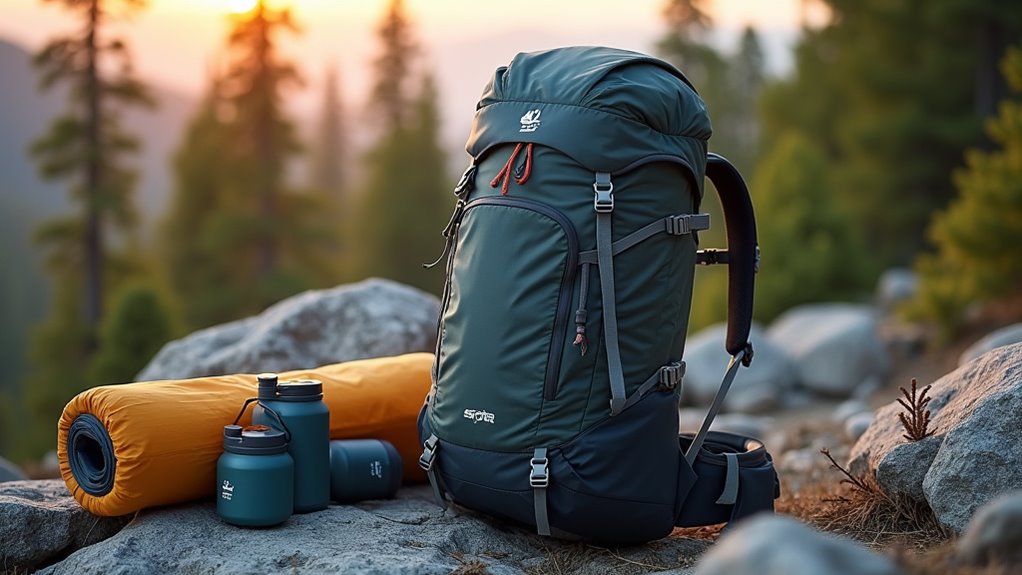
Improve your hiking comfort instantly by choosing the perfect camping backpack that eliminates shoulder pain and transforms grueling treks into enjoyable adventures.
You’ve probably felt that nagging ache in your shoulders or lower back after a day on the trail—that’s your backpack telling you something’s wrong. Whether it’s poor fit, wrong capacity, or terrible packing technique, the wrong gear choice can turn your outdoor adventure into an endurance test. But here’s the thing: selecting and using the right camping backpack isn’t rocket science, and the difference it makes is immediate and dramatic. Let’s fix this problem once and for all.
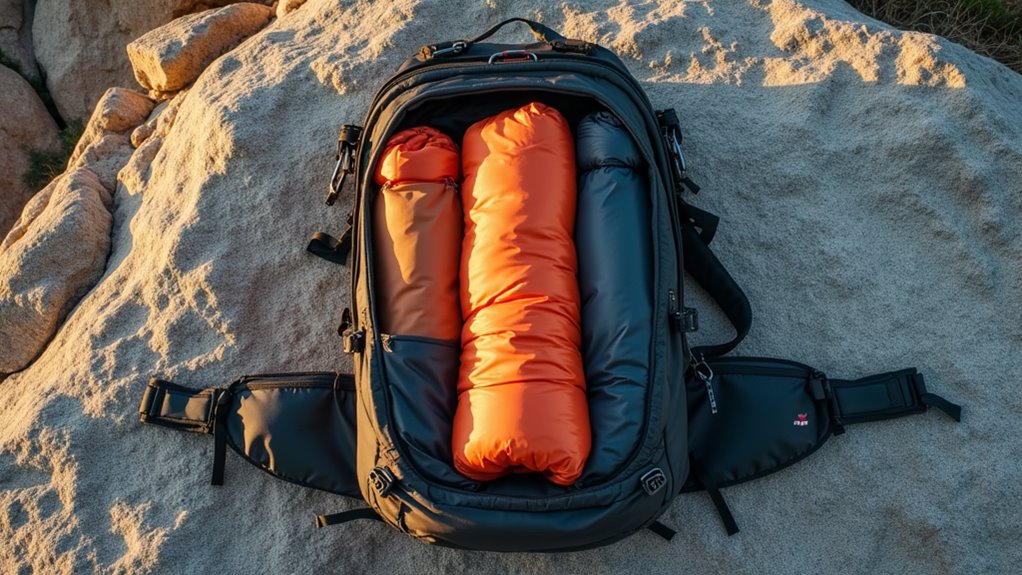
When you’re shopping for a camping backpack, you’ll want to focus on several key features that can make or break your outdoor experience. Start with capacity – choose 30-50 liters for day trips or 60+ liters for multi-day adventures.
Selecting the right camping backpack capacity is crucial – 30-50 liters suits day hikes while 60+ liters handles extended wilderness adventures.
Check the frame system; internal frames offer better stability while external frames provide superior ventilation. Look for adjustable torso length to ensure proper fit and weight distribution.
Don’t overlook compartmentalization. Multiple pockets and dividers help organize gear efficiently. Water-resistant materials and sealed zippers protect your equipment from moisture.
Padded shoulder straps and hip belts reduce fatigue during long hikes. Side compression straps secure your load and prevent shifting.
Finally, examine the suspension system. Quality backpacks feature load-lifter straps and sternum belts that transfer weight effectively, keeping you comfortable throughout your journey.
Remember that selecting the perfect outdoor backpack requires balancing all these features with your specific hiking needs and budget constraints.
Since your outdoor adventures vary dramatically in scope and duration, choosing the right type of camping backpack becomes essential for success.
Day packs work perfectly for short hikes under 20 miles, offering 20-35 liter capacity for water, snacks, and basic gear.
Weekend packs handle 2-3 day trips with 35-50 liters of space for extra clothing and lightweight camping equipment.
Multi-day backpacks provide 50-70 liters for extended adventures requiring more food, cooking gear, and shelter.
Expedition packs offer 70+ liters for serious backcountry expeditions lasting weeks.
Internal frame packs excel on maintained trails with better weight distribution, while external frame packs work best for heavy loads and off-trail terrain.
For those seeking a different outdoor experience, caravan camping offers a comfortable base camp approach that eliminates the need for carrying all your gear on your back.
Match your pack’s capacity and design to your specific adventure length and difficulty level.
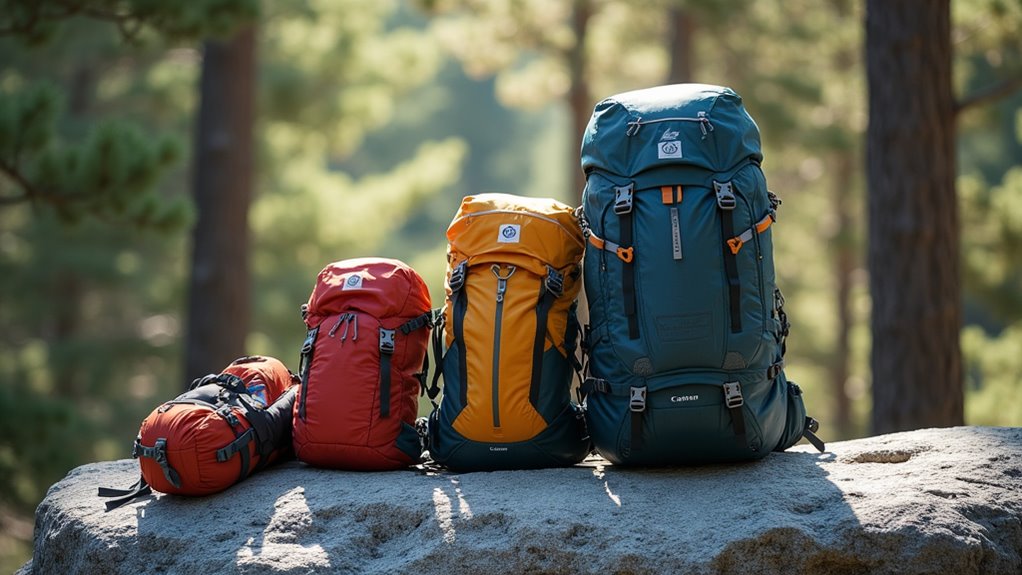
Finding your ideal backpack size requires honest assessment of your gear needs and hiking habits. Start by laying out everything you’ll carry on typical trips.
Weekend outings usually need 30-50 liter packs, while week-long adventures require 50-70 liters. Multi-week expeditions demand 70+ liters.
Consider your shelter type—ultralight gear means smaller packs, while car camping equipment needs more space. Factor in seasonal variations too. Winter camping requires bulkier clothing and four-season gear, increasing capacity needs considerably.
Don’t oversize your pack thinking bigger’s better. Large packs tempt you to overpack, creating unnecessary weight. Match capacity to actual requirements, not wishful thinking.
Try packing your gear in different sized packs at outdoor stores. The right size feels comfortable when fully loaded and doesn’t leave excessive empty space that shifts during hiking. Remember that proper backpacking preparation extends beyond just pack size and includes planning your entire gear system for maximum comfort on the trail.
Proper weight distribution transforms an uncomfortable slog into an enjoyable hike. You’ll want to pack heavy items close to your back and centered between your shoulder blades. This keeps the weight balanced and prevents the pack from pulling you backward.
Place medium-weight gear in the middle sections, while lighter items go at the bottom and top. Keep frequently used items in external pockets for easy access without disturbing your main pack organization.
Adjust your shoulder straps so they carry about 20% of the weight, with your hip belt supporting the remaining 80%. Tighten the load lifter straps to pull the pack closer to your body.
Test your setup by walking around before hitting the trail – you shouldn’t feel the pack swaying or pulling unnaturally. When winter camping involves activities like ice fishing, ensuring proper weight distribution becomes even more critical for maintaining balance and safety on ice.
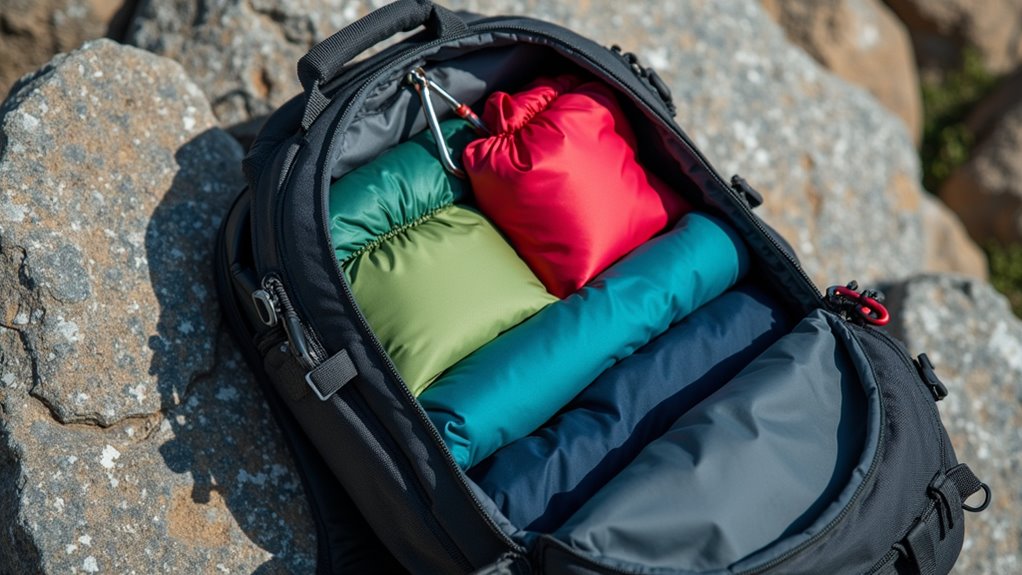
Beyond getting the weight positioned correctly, smart packing strategies will make your gear accessible when you need it most. You’ll save time and frustration when everything has its designated spot.
Essential Packing Zones:
Use stuff sacks to compartmentalize similar items together. This prevents smaller gear from disappearing into your pack’s depths.
Pack items you’ll need first on top or in external pockets.
While some campers prefer to throw everything into their camping bags randomly, this approach leads to disorganization and wasted time searching for essential items.
When you’re miles from shelter and storm clouds roll in, your backpack becomes your gear’s last line of defense against the elements. Look for waterproof or water-resistant materials like ripstop nylon with DWR coating. Sealed seams prevent water from sneaking through stitching lines, while YKK zippers resist moisture better than cheaper alternatives.
Durability matters just as much. Heavy-duty fabrics withstand sharp rocks and thorny branches without tearing. Reinforced stress points at straps and bottom panels extend your pack’s lifespan considerably. Don’t overlook UV resistance—constant sun exposure weakens materials over time.
Consider a rain cover for extra protection during downpours. It’s lightweight insurance that keeps everything bone-dry. Test zippers and buckles regularly; they’re common failure points that can ruin your trip. For single mothers embarking on camping adventures, a reliable weatherproof backpack provides peace of mind when managing solo outdoor experiences with children.
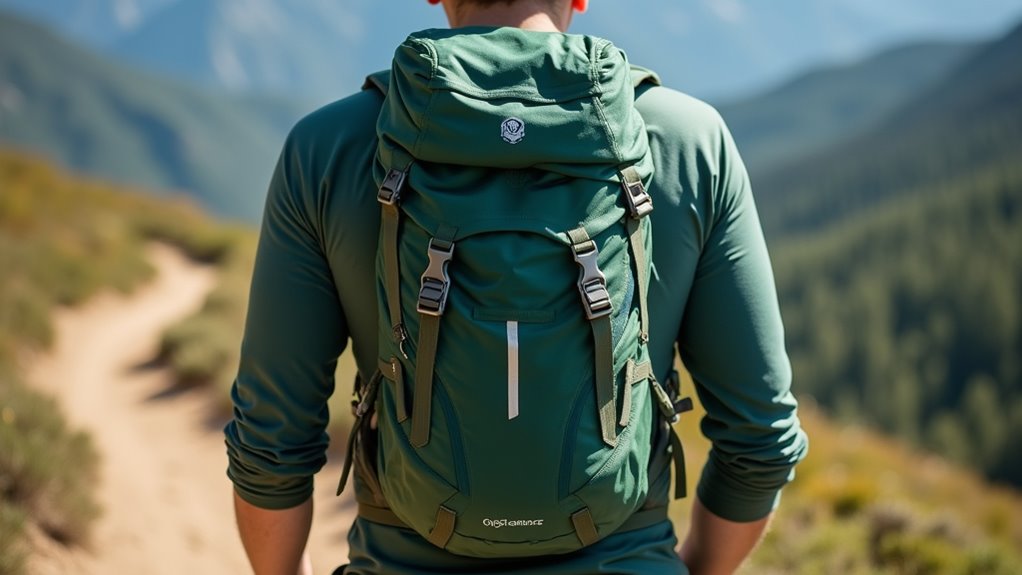
Even the most expensive backpack becomes a torture device if it doesn’t fit your body correctly. You’ll develop hot spots, shoulder pain, and hip bruises that’ll make every mile miserable. Proper fitting isn’t optional—it’s essential for long-distance success.
Start by measuring your torso length from your C7 vertebra to your iliac crest. Most backpacks come in specific torso sizes, not just small, medium, or large. Here’s what you need to nail:
Don’t rush this process—your comfort depends on it. Beyond proper fit, focus on selecting essential items that will make your hiking experience both safe and enjoyable.
A perfectly fitted backpack won’t stay that way if you neglect basic maintenance. Clean your pack regularly with mild soap and lukewarm water, focusing on zippers and buckles. Don’t machine wash unless the manufacturer specifically allows it.
Air-dry completely before storing to prevent mold and mildew.
Lubricate zippers monthly with wax or specialized zipper lubricant. Check seams, straps, and buckles for wear after each trip. Replace worn components immediately – a broken buckle can ruin your hike.
Store your backpack loosely packed in a dry place, never compressed for extended periods.
Treat tears promptly with fabric patches or seam sealer. Keep your pack away from sharp objects and excessive heat.
Just as you’d research the best camping lantern for your outdoor adventures, take time to learn proper backpack care techniques specific to your pack’s materials and design.
With proper care, you’ll get years of reliable service from your investment.
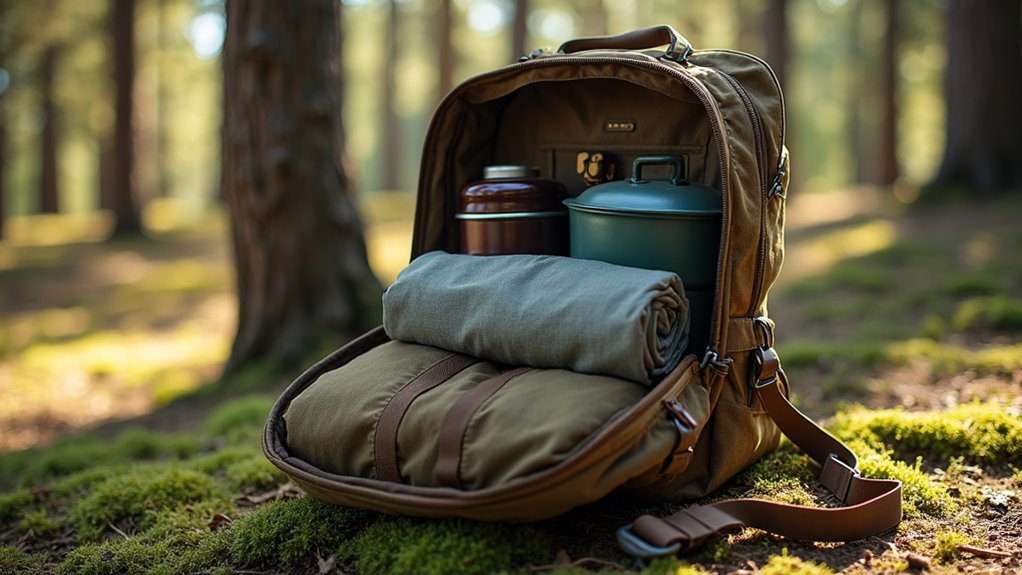
While premium backpacks can cost hundreds of dollars, you don’t need to break the bank to find reliable gear that’ll handle your camping adventures. Smart shoppers can secure quality packs for under $100 by focusing on essential features rather than brand names.
Look for these key indicators of value:
Research lesser-known brands that prioritize function over flashy marketing. Check online reviews from actual campers, not just gear reviewers.
Consider last season’s models from established brands – they’re often discounted substantially while offering identical performance to current versions. With the current economic conditions affecting outdoor recreation retailers, many dealers are offering deeper discounts to move inventory, making it an ideal time to purchase quality camping gear.
Your backpack is your faithful sherpa on every adventure—choose wisely and it’ll carry you through countless trails ahead. You’ve got the knowledge now: match capacity to your trip length, prioritize proper fit over flashy features, and don’t skimp on quality construction. Pack smart with heavier gear close to your back, maintain it regularly, and you’ll have a reliable companion that won’t let you down when the trail gets tough.